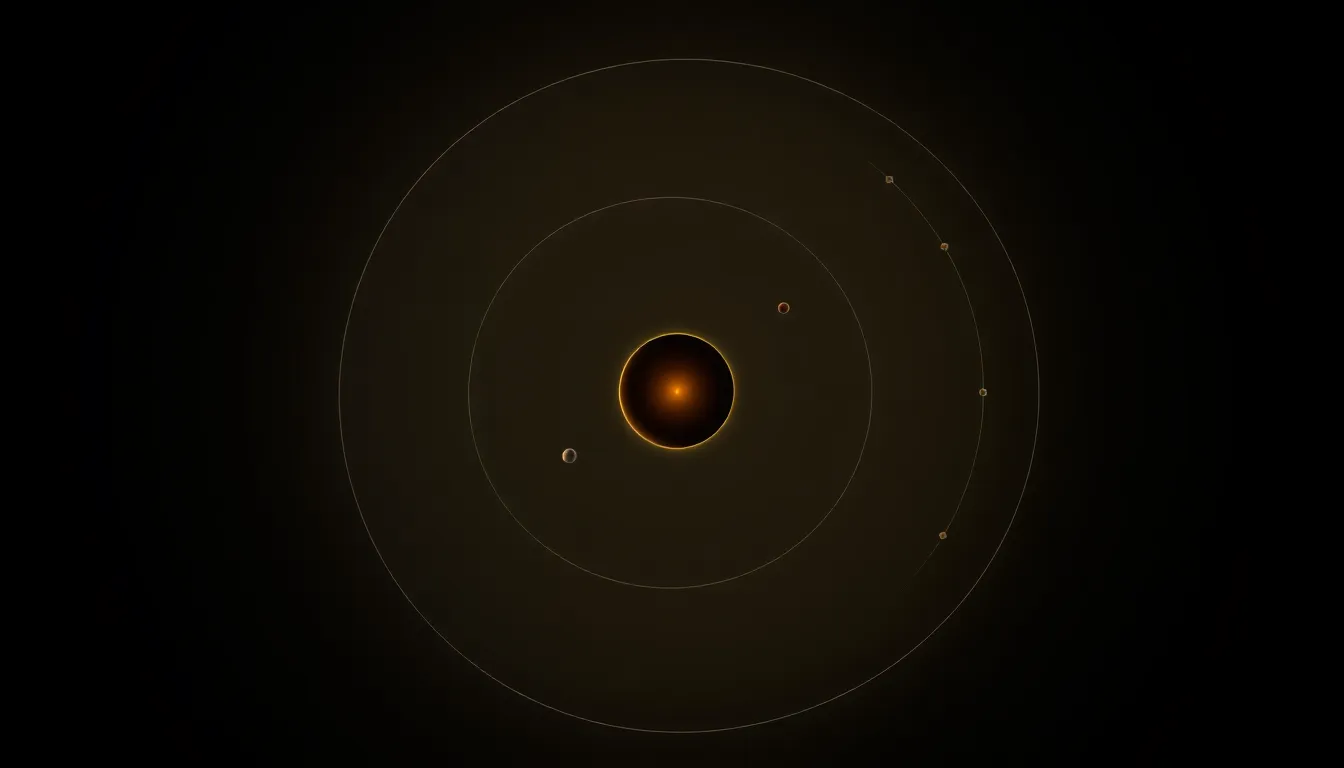Table of Contents
TogglePlanetary orbits are a fascinating aspect of our solar system, revealing the intricate dance between celestial bodies. These orbits dictate how planets move around the sun, influenced by gravitational forces and the laws of physics. Understanding these movements not only enhances knowledge of our own planet but also sheds light on the formation and behavior of distant worlds.
As scientists delve deeper into the mechanics of planetary orbits, they uncover patterns that can predict future celestial events. From the elliptical paths of planets to the complexities of resonance and perturbation, each orbit tells a unique story. This exploration opens doors to new discoveries about the universe, making it an exciting topic for both enthusiasts and scholars alike.
Overview of Planetary Orbits
Planetary orbits represent the paths that celestial bodies follow as they travel around a star, typically shaped by gravitational forces. Each planet in the solar system orbits the sun in an elliptical shape, adhering to Kepler’s laws of planetary motion. These laws state that:
- Elliptical Orbits: Planets move in ellipses with the sun at one focus of the ellipse.
- Equal Areas: A line segment joining a planet and the sun sweeps out equal areas during equal intervals of time.
- Orbital Periods: The square of the orbital period of a planet is proportional to the cube of the semi-major axis of its orbit.
The distance from the sun influences orbital speed. Closer planets, like Mercury and Venus, orbit faster than outer planets such as Neptune and Uranus. This variance is due to the gravitational pull exerted by the sun, which decreases with distance.
In addition to the sun’s gravity, other celestial forces contribute to these orbital dynamics. The gravitational influences of other planets can cause perturbations, resulting in slight variations in orbits. These perturbations can lead to long-term changes in a planet’s motion.
Understanding planetary orbits enhances comprehension of celestial mechanics and planetary system evolution. Observations of multi-planet systems reveal intricate gravitational interactions, while ongoing studies predict phenomena such as planetary alignments and eclipses. Collectively, these insights provide a deeper appreciation of the cosmos and underscore the significance of gravitational forces in shaping the universe.
Types of Planetary Orbits

Planetary orbits take on various forms, prominently featuring circular and elliptical shapes. Each type plays a vital role in the dynamics of celestial bodies within a star system.
Circular Orbits
Circular orbits occur when a planet’s distance from its star remains constant, creating a perfect circle. In this case, gravitational forces balance centripetal force, resulting in a stable path. Circular orbits represent an ideal scenario, as seen with some moons and artificial satellites. An example includes the orbits of several exoplanets discovered around their stars, often found in close proximity with nearly circular paths.
Elliptical Orbits
Elliptical orbits present a more common occurrence among planets, following the laws established by Johannes Kepler. In this configuration, a planet moves in an elongated oval shape, with two focal points. One focus houses the star, while the other remains empty. Elliptical orbits possess varying distances from the star, leading to changes in orbital speed—planets travel faster when closer and slower when farther away. Notable examples include Earth’s orbit, which has a slight elliptical shape, contributing to seasonal changes experienced throughout the year.
Factors Influencing Planetary Orbits
Various factors shape planetary orbits, impacting their paths and behaviors within the solar system. Understanding these factors deepens insights into celestial mechanics and planetary dynamics.
Gravitational Forces
Gravitational forces play a crucial role in determining planetary orbits. The sun’s gravitational pull exerts the strongest influence on planets, keeping them in their respective paths. Newton’s law of universal gravitation quantifies this attraction, highlighting how mass and distance affect gravitational strength. As planets orbit, the balance between gravitational pull and centrifugal force creates stable orbits. Additionally, gravitational interactions between planets contribute to orbit perturbations. For example, Jupiter’s massive gravitational field can influence the trajectories of nearby asteroids and smaller planetoids, altering their orbits over time.
Speed and Velocity
Speed and velocity significantly affect orbital conditions. A planet’s orbital speed varies based on its distance from the sun, adhering to Kepler’s laws. Closer planets, such as Mercury, experience stronger gravitational forces, leading to higher orbital speeds, while distant planets like Neptune orbit more slowly. Velocity changes during an orbit reflects the conservation of angular momentum. As a planet approaches the sun, it accelerates, while it decelerates when moving away. These variations ensure that planetary orbits remain stable, facilitating the predictable movements observed in our solar system.
Observational Techniques
Observational techniques play a crucial role in studying planetary orbits. Two primary methods—telescopes and space probes—provide insights into celestial bodies and their movements.
Telescopes and Spectroscopy
Telescopes enable astronomers to observe planetary orbits from Earth and space. Ground-based telescopes, equipped with adaptive optics, minimize atmospheric distortion, enhancing image clarity. Space telescopes, like the Hubble Space Telescope, eliminate atmospheric interference altogether, capturing high-resolution images of distant planets and their orbits.
Spectroscopy complements telescopic observations by analyzing light from celestial objects. It identifies chemical compositions and physical properties. Doppler spectroscopy, for instance, detects wobbles in stars caused by orbiting planets’ gravitational pulls, providing data on planetary masses and distances. The combined use of telescopes and spectroscopy allows scientists to track orbital patterns over time, revealing valuable information about planetary behaviors and formations.
Space Probes
Space probes offer direct data on planetary orbits by traveling to celestial bodies within our solar system. These unmanned spacecraft gather real-time information on planets, moons, and asteroids. For example, NASA’s Juno probe is studying Jupiter’s gravitational field, providing insights into its orbit and internal structure.
Space probes also use gravity assists to gain speed and adjust trajectories during missions. This technique involves using the gravitational pull of other bodies to slingshot around them, optimizing travel time and fuel efficiency. Data retrieved from space probes enhances understanding of orbital mechanics and informs the study of planetary evolution.
Implications of Orbital Mechanics
Orbital mechanics carries significant implications that affect our understanding of the solar system and beyond. Predicting celestial events relies on the principles of orbital mechanics. Determining planet positions and movements helps astronomers forecast eclipses, transits, and conjunctions. This predictive capability enhances navigation for space missions, allowing for optimal trajectory planning.
Orbital mechanics also influences climate and environmental patterns on Earth. Variations in Earth’s orbit, influenced by gravitational interactions with other celestial bodies, may lead to changes in climate cycles, such as ice ages. Understanding these cyclical patterns in Earth’s orbit assists scientists in studying long-term climate trends.
Moreover, gravitational interactions among planets prompt the study of stability and chaos within orbits. Analyzing the stability of a planetary system determines whether planets remain in predictable orbits or experience chaotic movements. Chaotic behavior can lead to potential impacts on planetary bodies, making this analysis essential for understanding the evolution of solar systems.
The implications extend to the potential for habitable planets beyond our solar system. Recognizing the criteria for stable orbits allows researchers to identify exoplanets that may support life. Identifying a planet’s habitable zone—where liquid water can exist—depends significantly on its orbital parameters.
Technological advancements play a key role in understanding orbital mechanics. Enhanced computer simulations provide insights into complex orbital interactions, allowing scientists to visualize and predict long-term orbital changes. This progress facilitates more accurate models of planetary systems, advancing knowledge in astrophysics.
These implications of orbital mechanics inform the scientific community and support various fields such as astrophysics, planetary science, and astrobiology. Understanding orbital dynamics, gravitational forces, and their effects allows for informed studies, predictions, and discoveries about our universe.
Understanding planetary orbits is essential for grasping the complexities of our solar system. These intricate paths reveal not only the forces at play but also the broader implications for celestial mechanics and climate patterns. As scientists continue to refine observational techniques and leverage technology, the mysteries of orbital dynamics become clearer.
This knowledge enhances predictions of celestial events and informs the search for potentially habitable exoplanets. The study of planetary orbits is a gateway to deeper insights about the universe, fostering a greater appreciation for the cosmic dance of celestial bodies.







